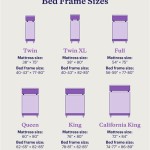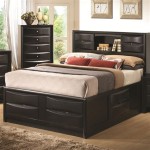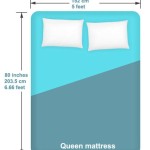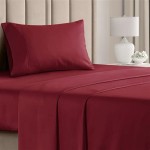What Size Rug for a Double Bed: A Comprehensive Guide
Selecting the appropriate rug size for a double bed significantly impacts a bedroom's aesthetics and functionality. A correctly sized rug anchors the bed, unifies the room's design, and contributes to overall comfort. Conversely, an improperly sized rug can disrupt the room's balance, making the space feel smaller or disjointed. This article provides a comprehensive guide to determining the optimal rug size for a double bed, considering various factors and offering practical recommendations.
The term "double bed," also frequently referred to as a full-size bed, typically measures 54 inches wide (137 cm) and 75 inches long (191 cm). These dimensions serve as the foundation for calculating the appropriate rug size. However, other elements, such as the room's overall size, furniture placement, and desired style, also influence the final decision. Understanding these factors ensures a harmoniously designed and functional bedroom space.
Key Point 1: Standard Rug Sizes and Placement Options
Various standard rug sizes complement a double bed, each creating a distinct visual effect. The selection primarily depends on the desired amount of rug coverage around the bed and the overall room dimensions. Common options include 5x8, 6x9, and 8x10 rugs. It’s crucial to understand how each size interacts with the bed and the surrounding floor space.
The 5x8 rug is typically the smallest size recommended for a double bed. When placed horizontally under the bed, it allows the rug to extend approximately 18 inches on each side of the bed and at the foot, assuming the bed is centered. This option is suitable for smaller bedrooms where maximizing floor space is a priority. It provides a soft landing for feet upon waking and defines the sleeping area without overwhelming the room.
A 6x9 rug offers more coverage compared to a 5x8. With this size, the rug extends approximately 24 inches on each side of the bed and at the foot. This provides a more substantial visual anchor and a more comfortable surface area surrounding the bed. It’s a versatile option suitable for medium-sized bedrooms, offering a balance between coverage and floor space preservation. This size allows for a greater portion of the bed to sit atop the rug, enhancing the room’s perceived size.
The 8x10 rug provides the most comprehensive coverage and is often preferred for larger bedrooms. It allows for approximately 36 inches of rug extending from each side and the foot of the bed. This size creates a luxurious and expansive feel, anchoring the entire sleeping area and unifying the room's design. With an 8x10 rug, nightstands can often be placed entirely on the rug, further defining the bed area as a distinct zone within the larger space.
Placement is critical, regardless of the rug size chosen. The most common placement involves positioning the rug horizontally under the bed, ensuring it extends evenly on both sides and at the foot. This creates a balanced and visually appealing aesthetic. Another option is to place the rug only under the bottom two-thirds of the bed, leaving the headboard end exposed. This approach works well in smaller spaces and can create a more casual and less formal look. Carefully measure the space and consider the furniture arrangement to determine the optimal placement for the chosen rug size.
Key Point 2: Considering Room Size and Furniture Arrangement
The room's overall size and the placement of other furniture pieces significantly influence the ideal rug size for a double bed. A rug that is too large can overwhelm a small room, making it feel cramped and cluttered. Conversely, a rug that is too small can appear insignificant and fail to adequately anchor the bed. Analyzing the room’s dimensions and the placement of surrounding furniture is crucial for selecting the right rug size.
In a small bedroom, a 5x8 rug may be the most practical choice. It provides sufficient coverage around the bed without sacrificing valuable floor space. To further maximize the room's perceived size, consider a rug with a light color and minimal pattern. This will help to create a sense of openness and airiness. Avoid placing additional furniture entirely on the rug, as this can further contribute to a cluttered appearance.
In a medium-sized bedroom, a 6x9 rug offers a balanced solution. It provides ample coverage around the bed while still leaving sufficient floor space visible. This size allows for more flexibility in furniture placement. Nightstands can be partially or fully placed on the rug, depending on their size and the overall room layout. Consider the placement of other furniture pieces, such as dressers or chairs, to ensure the rug complements the overall design and does not obstruct walkways.
In a large bedroom, an 8x10 rug can be the perfect choice for creating a luxurious and cohesive look. It provides extensive coverage, anchoring the entire bed area and unifying the room's design. With this size, nightstands can typically be placed entirely on the rug, further defining the sleeping zone. Consider the placement of other furniture pieces, such as a seating area or a desk, to ensure the rug complements the entire room's layout and creates a harmonious flow.
Beyond the standard sizes, consider the room's shape. A long, narrow room might benefit from a runner rug placed alongside the bed to visually widen the space. An irregularly shaped room may require a custom-sized rug to perfectly fit the available area. Always measure the room carefully and consider the placement of existing furniture before making a final decision on rug size.
Key Point 3: Style and Design Considerations
Beyond size and placement, the rug's style and design play a crucial role in completing the overall look of the bedroom. The rug should complement the existing décor, enhancing the room's aesthetic and reflecting the homeowner's personal style. Color, pattern, and texture are important factors to consider when selecting the ideal rug.
Color is a fundamental element of rug design. A rug's color can either blend seamlessly with the existing décor or serve as a focal point, adding a pop of visual interest. Neutral-colored rugs, such as beige, gray, or ivory, are versatile and can complement a wide range of color schemes. They create a calm and serene atmosphere, ideal for a bedroom. Boldly colored rugs, such as blue, green, or red, can add vibrancy and personality to the room, but should be carefully chosen to ensure they harmonize with the existing décor.
Pattern is another important consideration. A patterned rug can add visual interest and depth to the room. Geometric patterns, such as stripes or chevrons, can create a modern and contemporary look. Floral patterns can add a touch of elegance and femininity. Abstract patterns can add a sense of artistic flair. When choosing a patterned rug, consider the existing patterns in the room, such as wallpaper or bedding, to ensure they complement each other and avoid creating a cluttered or overwhelming effect.
Texture also plays a significant role in the rug's overall aesthetic. A plush, high-pile rug can add a sense of luxury and comfort, while a flat-weave rug can create a more casual and understated look. Consider the rug's texture in relation to the other textures in the room, such as bedding and curtains, to create a cohesive and harmonious design. A shag rug adds a soft, warm element, while a woven rug brings an earthy, natural feel.
Ultimately, the ideal rug style and design are a matter of personal preference. However, considering the room's existing décor, the desired aesthetic, and the rug's overall impact on the space is essential. Samples should be viewed in the room's lighting conditions to accurately assess color and texture. Some designers recommend layering rugs to add more depth and visual interest to the space.
Choosing the correct rug material is also vital. Wool rugs are durable, stain-resistant, and naturally flame-retardant, making them a good choice for high-traffic areas. Synthetic materials like nylon and polypropylene are budget-friendly and easy to clean. Natural fibers like jute and sisal offer a rustic, textured look but may not be as soft underfoot. The material should be selected according to lifestyle and budget constraints.
In summary, choosing the right rug size for a double bed involves careful consideration of several factors, including the bed's dimensions, the room's size, the furniture arrangement, and the desired style. By understanding these factors and applying the recommendations outlined in this article, one can confidently select the perfect rug to enhance the beauty and functionality of the bedroom.

Rug Under Bed Sizes King Queen Double Child Images Bennetts Carpets

A Guide To The Best Rug Size For Your Space

Rug Size Guide For A Bedroom

What Size Rug Should I Use Under A Bed Mcqueens Interiors

What Diffe Rug Sizes Look Like Under A Full Double Bed Images

Size Guide Rugs A Million

Area Rug Size Guides For Twin And Queen Beds

What Diffe Rug Sizes Look Like Under A Full Double Bed Images

Rug Size Guide For A Bedroom

How Big Should A Rug Be In Bedroom Ultimate Guide








